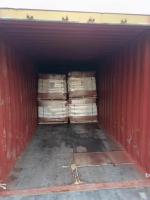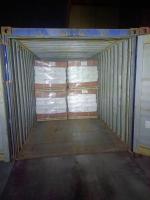Our Products
Product Center / Alumina red mud settling flocculant in mineral processing

Alumina red mud settling flocculant in mineral processing
At present, alumina production materials vary greatly. Different production processes and bauxite sources all have a great impact on the composition and characteristics of alumina production materials. For example, Bayer method for separating settling materials and sintering method for separating settling materials; The materials diluted and separated by Bayer method (Nk, 150g/L) and washed by Bayer method (Nk, 50g/L), and the materials diluted and separated by sintering method (Nk, 110g/L) and washed and separated by sintering method (Nk, 10g/L) are difficult to be settled and separated by using the same flocculant. Therefore, a variety of different flocculants are needed to speed up separation.
The sedimentation and separation of red mud is one of the main processes in the Bayer process of alumina production, which plays a role of connecting the preceding and the following. In the production operation, the production can not proceed normally due to the poor solid-liquid separation, which directly affects the solid-liquid separation efficiency and alumina yield. Therefore, improving the solid-liquid separation efficiency has become an important content of alumina production research. The sedimentation and separation of red mud is a very complicated physical and chemical process. Since the Baer process is a suspension formed by red mud and sodium aluminate solution, there are complex physical and chemical interactions between red mud particles and between red mud particles and solution. Red mud phase composition, particle size distribution, surface morphology of red mud particles, solid content and liquid composition of red mud slurry, as well as temperature of red mud slurry, all have significant effects on the settlement and separation process of red mud slurry [1-3]. According to the current alumina production situation, it is very difficult to double the separation speed if only from the research of separation equipment. If appropriate flocculant is selected, the flocculant technology can greatly improve the separation speed of solid and liquid and reduce the size of separation equipment. Different dissolved pulp has different settling performance, so it is necessary to select suitable polymer flocculant through experimental study, so as to realize efficient separation of red mud [4-6].
There are many kinds of flocculants, anionic flocculants are used in the process of alumina production. The anionic flocculants used in Zhongzhou branch are mainly copolymers of acrylamide and acrylic acid. There are many factors affecting the flocculation effect of synthetic flocculants, among which one of the main factors is the property of red mud slurry, that is, the mineral composition and particle size distribution of red mud, especially the composition of the solution. The key is to select the flocculant whose composition and properties are suitable for the red mud slurry and carry out the operation correctly.
The particles in sintering materials are large and easy to settle after adding flocculant. The Bayer process of mineral processing materials uses grinding flotation, the content of fine particles in the materials is high, which requires the flocculant to have higher flocculation capacity, and can keep the superliquant clear. Especially after the bauxite from Indonesia is added into the ore source, it becomes more difficult to meet the above conditions. At present, the method of mixed use of domestic high molecular weight anionic flocculant and imported flocculant is adopted, but the settling effect is not good and needs to be improved.
Molecular weight is the most basic performance parameter of synthetic flocculant. Many aluminum oxide plants take molecular weight as an important standard to evaluate the quality of flocculant. Flocculants are generally linear structure compounds, the larger the molecular weight, the longer the hydrocarbon chain, the more effective functional groups contained, the more adsorption capacity of the particles, but if the molecular weight is larger, its water solubility decreases, and in the process of mixing with particles, molecules can not be fully extended, affecting the contact adsorption between it and the particles, thus affecting the flocculation effect. The molecular weight of flocculant for red mud settlement and separation is more strict.
The temperature of diluted pulp is one of the main factors affecting the settling behavior of red mud. When other conditions are the same, the dilution pulp temperature has a great influence on the settling behavior of red mud. The higher the temperature, the faster the settling speed. Therefore, in industrial production, it is necessary to control the dilution pulp temperature as high as possible to ensure the smooth settlement and separation process of red mud.
At present, alumina production materials vary greatly. Different production processes and bauxite sources all have a great impact on the composition and characteristics of alumina production materials. For example, Bayer method for separating settling materials and sintering method for separating settling materials; The materials diluted and separated by Bayer method (Nk, 150g/L) and washed by Bayer method (Nk, 50g/L), and the materials diluted and separated by sintering method (Nk, 110g/L) and washed and separated by sintering method (Nk, 10g/L) are difficult to be settled and separated by using the same flocculant. Therefore, a variety of different flocculants are needed to speed up separation.
The sedimentation and separation of red mud is one of the main processes in the Bayer process of alumina production, which plays a role of connecting the preceding and the following. In the production operation, the production can not proceed normally due to the poor solid-liquid separation, which directly affects the solid-liquid separation efficiency and alumina yield. Therefore, improving the solid-liquid separation efficiency has become an important content of alumina production research. The sedimentation and separation of red mud is a very complicated physical and chemical process. Since the Baer process is a suspension formed by red mud and sodium aluminate solution, there are complex physical and chemical interactions between red mud particles and between red mud particles and solution. Red mud phase composition, particle size distribution, surface morphology of red mud particles, solid content and liquid composition of red mud slurry, as well as temperature of red mud slurry, all have significant effects on the settlement and separation process of red mud slurry [1-3]. According to the current alumina production situation, it is very difficult to double the separation speed if only from the research of separation equipment. If appropriate flocculant is selected, the flocculant technology can greatly improve the separation speed of solid and liquid and reduce the size of separation equipment. Different dissolved pulp has different settling performance, so it is necessary to select suitable polymer flocculant through experimental study, so as to realize efficient separation of red mud [4-6].
There are many kinds of flocculants, anionic flocculants are used in the process of alumina production. The anionic flocculants used in Zhongzhou branch are mainly copolymers of acrylamide and acrylic acid. There are many factors affecting the flocculation effect of synthetic flocculants, among which one of the main factors is the property of red mud slurry, that is, the mineral composition and particle size distribution of red mud, especially the composition of the solution. The key is to select the flocculant whose composition and properties are suitable for the red mud slurry and carry out the operation correctly.
The particles in sintering materials are large and easy to settle after adding flocculant. The Bayer process of mineral processing materials uses grinding flotation, the content of fine particles in the materials is high, which requires the flocculant to have higher flocculation capacity, and can keep the superliquant clear. Especially after the bauxite from Indonesia is added into the ore source, it becomes more difficult to meet the above conditions. At present, the method of mixed use of domestic high molecular weight anionic flocculant and imported flocculant is adopted, but the settling effect is not good and needs to be improved.
Molecular weight is the most basic performance parameter of synthetic flocculant. Many aluminum oxide plants take molecular weight as an important standard to evaluate the quality of flocculant. Flocculants are generally linear structure compounds, the larger the molecular weight, the longer the hydrocarbon chain, the more effective functional groups contained, the more adsorption capacity of the particles, but if the molecular weight is larger, its water solubility decreases, and in the process of mixing with particles, molecules can not be fully extended, affecting the contact adsorption between it and the particles, thus affecting the flocculation effect. The molecular weight of flocculant for red mud settlement and separation is more strict.
The temperature of diluted pulp is one of the main factors affecting the settling behavior of red mud. When other conditions are the same, the dilution pulp temperature has a great influence on the settling behavior of red mud. The higher the temperature, the faster the settling speed. Therefore, in industrial production, it is necessary to control the dilution pulp temperature as high as possible to ensure the smooth settlement and separation process of red mud.



117_small.jpg)

190_small.jpg)